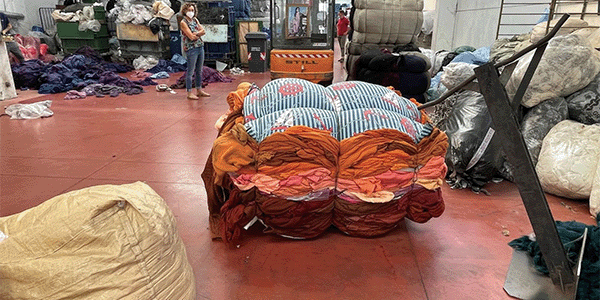
Image courtesy of Luum Textiles
Research published by the United Nations Environment Programme in March showed that 92 million tons of textile scrap is produced globally each year. Meanwhile, Ellen MacArthur Foundation research shows textile production doubled from 2000 to 2015, while the duration of garment use decreased by 36 percent.
Additionally, the foundation’s research noted that 11 percent of plastic scrap comes from clothing and textiles, with only 8 percent of textile fibers made from recycled sources by 2023.
With less than 15 percent of textile scrap recycled each year in the United States, and only 1 percent eventually processed and repurposed into new fabric, Luum Textiles has spent more than a decade working to close the loop on that material with its numerous product lines of fabric for use primarily in workplace, lifestyle, hospitality, wellness and higher education settings.
The midsize company says 70 percent of its fabrics, available in a multitude of colors and patterns, derive from recycled natural fibers, upcycled apparel or plastic bottles, while 25 percent of its products incorporate renewable fibers from virgin and recycled sources such as wool, cotton, silk and silicone.
Currently, Luum has seven products on its Garment Waste Platform (GWP), which were designed by former Creative Director Suzanne Tick: Everyday Boucle, Melange Check, Wool Fleck, Graph Speck, Forward Motion and Stability. An eighth textile by Tick will join the platform in September.
Thinking globally
Headquartered in Toronto, Luum was founded in 2013 on the belief that design is most successful when the creative process is paired with a clear design vision and performance intent, according to the company’s branding and marketing manager, Melanie Roven.
In addition to its Toronto base, Luum has a dedicated creative team in New York City that runs its daily operations under the creative direction of Dorothy Cosonas, who was appointed to the role in January. From that location, the creative team plans and prepares year-round for Luum’s three yearly fabric collection launches and conducts material research and development, discusses textile mill sources, marketing and strategy.

Luum also partners with artisans and mills worldwide to produce each new textile product, Roven says. In the case of Luum’s GWP, mills collect bales of pre- and postconsumer wool, acrylic, nylon and polyester garments, for example, shred them by color and content, then mélange them together to make new yarn colors, which then can be woven into various structures and layouts.
The company's network of mill partners spans North America, Europe and Asia.
“Part of Luum’s philosophy is to work with the partners whose strengths allow us to create new materials and use new technologies,” Roven says. “We review the techniques the mills use, how familiar they are with certain materials and learn if they’re able to produce what we’re looking for in a certain timeframe. Our mills are our partners, and we work together to bring the best possible result forward that is relevant for the time.”
Along with the company’s use of recycled content, it has developed six biodegradable synthetic textiles made from 100 percent postconsumer scrap. Roven says that, as a whole, pre- and postconsumer polyester, wool and cotton comprise the majority of Luum’s offerings.
“Luum’s Garment Waste Platform prioritizes sustainability through the use of recycled fibers and giving them a second life as high-performance textiles,” Roven says. “No additional water usage, PFAS [per- and polyfluoroalkyl substances], antimicrobials or fire-retardant finishes are present during the manufacturing process. This drastically reduces water and energy consumption—two major contributors to carbon emissions in textile production.”
Environmental stewardship
As it continues to develop new textile designs made with recycled materials, Luum has accrued a number of product certifications.
The company says more than 50 percent of its products are Declare and/or Red List Free approved. Declare offers an ingredient disclosure for what the organization calls “healthy building products,” while Red List Free certification indicates that textiles are free from harmful chemicals.
More than 80 percent of Luum’s products meet the tenets of the Healthier Hospitals Initiative, while more than 90 percent are Clean Air Gold or Silver certified. The three leathers Luum manufactures are certified Gold by the Leather Working Group.
Roven says sustainability is woven into the company’s ethos.
“Honoring the earth and being mindful about the materials we source for new textiles is woven into our design conversations daily,” she says. “This value will be reflected in the 2025 collections [in May and September] and beyond.”
Latest from Recycling Today
- China to introduce steel export quotas
- Thyssenkrupp idles capacity in Europe
- Phoenix Technologies closes Ohio rPET facility
- EPA selects 2 governments in Pennsylvania to receive recycling, waste grants
- NWRA Florida Chapter announces 2025 Legislative Champion Awards
- Goldman Sachs Research: Copper prices to decline in 2026
- Tomra opens London RVM showroom
- Ball Corp. makes European investment





